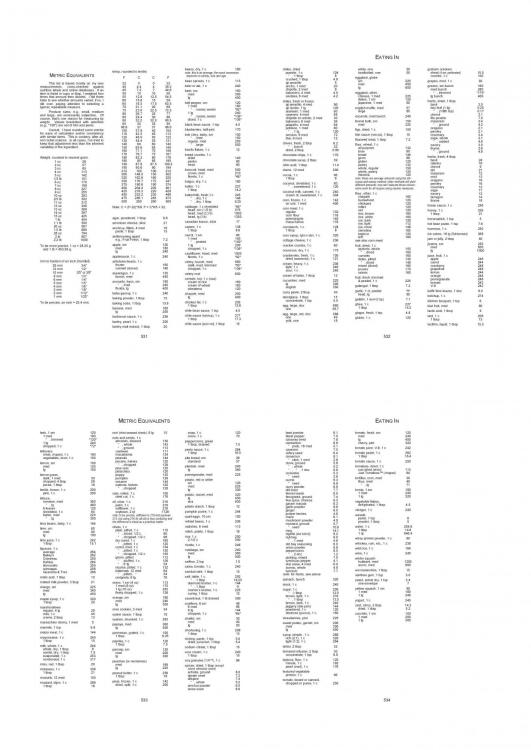-
Posts
621 -
Joined
-
Last visited
Profile Information
-
Location
San Francisco
Recent Profile Visitors
The recent visitors block is disabled and is not being shown to other users.
-
Michael, I notice this is a hobby of yours. Prior threads in a similar vein include Baking Formula (2008), Need input on baked goods calculator (2010), Input needed for recipe analysis technique (2010) and Cookie Recipe Creator (2011). From these, it's evident this way of looking at recipes works for you. It doesn't follow, however, that it works for anyone else. Focusing on the thread title rather than the calculator, as blue dolphin says, very few people (almost no one) tries to develop unique recipes. Rather, almost all recipes are either variations on a prior one or a synthesis of several. On the rare occasion I do tackle what I call a "blue sky" recipe, it consists of putting ingredients on the counter based on experience and intuition, then doing trial after trial. Asking me to explain how I make it work is like asking a musician to explain how s/he writes a song. Can't imagine a scenario, though, where a tool like you're trying to devise would be helpful.. Also, I don't think anyone is going to take the time to enter a bunch of data to get an analysis. I know I won't.
-
A cup in the U.S. is 236.6 milliliters. For more on the subject, see Wiki.
-
FWIW, I read the 4up version with a magnifying glass myself. But it's a handier size for keeping on the wall. The text size for the regular version (second link) is pretty easy, I think. Wheat germ is there (88g per cup); it's just that it's listed under flour. Whether to group related items was a difficult decision because it leads to problems like this. I went with grouping because it helps see patterns. Also, the recipes have the conversions already calculated, so it's not like someone has to find this entry to cook the dish. Neither of the other two come up in my recipes and, so, didn't make the list. I do dual measures for two reasons. First, they help give a sense of scale. Even if I at some point flip priority and lead with metric in my recipes (for the time being, it's the other way round), pretty sure I'll always retain volume for that reason. Second, I share recipes with folks who mostly aren't accustomed to working by weight. It's a cookbook, not a polemic.
-
Sorry. Working fine for me in Firefox. Closed my browser and reopened to make sure not loading from cache. Maybe it's the gremlins. ETA: Also working fine in Explorer and Chrome.
-
Frankly, I don't find databases helpful. Instead, I developed my own chart of equivalents, which I'm posting in another thread rather than risk taking this one off topic.
-
A recent thread by Michael Ohene reminded me that I've been meaning to post a conversion table I worked up last year for the purpose of adding dual measures to my personal cookbook (not published, just something I share with family and friends). There's a similar thread Chris Amirault started in 2011, but that was focused on testing converted recipes, so I felt this older thread was more appropriate for posting my table. Notice, though, that the latter thread includes links to other converters, including a spreadsheet by Martin Lersch. One reason I did this table was that I found the online converters a PITA to use, as you have to query a database with a lookup box. There are a few tables one can skim by eye, but they're limited in scope. For that matter, the databases also missed a lot of things. So I built this table from the ground up, measuring everything myself (many times). No doubt there are a few errors (and some measures depend on technique), but on the whole I thought it useful enough to warrant posting. So folks will know what to expect, I'm inserting a picture of the table, followed by pdf's which can be downloaded and printed. One pdf looks like the picture, the other is four regular sized pages. ETA: To clarify, an American cup is 236.6 milliliters. A tbsp is 1/16th of this, generally rounded for conversion purposes to 15 milliliters; by extension, this means a tsp is 5 milliliters. In fact, except for large quantities, I convert water and similar liquids at 240 grams per cup, and use weight not volume; dairy and oil, etc. I do by true weight. Here's a sample recipe which illustrates how I use this table: Trifle.pdf. Metric Equivalents (4up).pdf Metric Equivalents.pdf
-
Yes, you're fine. And looks like a good recipe. Notice you judge when done in stage two by weight and feel. The time frame is just for reference. BTW, the reason lean takes longer is that muscle has more water than does fat tissue.
-
The whole point of an equilibrium cure is that there isn't any excess salt. Nor is it unusual for there to be no water in the bag. They're doing the process in two steps because diffusion needs water to work; you'll pull out water in step two. What you're describing is fairly similar to how Batali does his guanciale, except he uses only a week for the first stage (which, in turn, is as much as I'd think it needs based on curing other things), then he hangs for three. BTW, it would be easier to discuss this if you'd either link or post the recipe you're using.
-
Suspension became common practice for two reasons. First was to deal with noncirculators, e.g., PID controlled crockpots and rice cookers, which was the state-of-the-art consumer rig until the SVS was introduced in late 2009. The SVS uses a rack rather than clips. Anyhoo, there's no need to suspend the bags in a circulator for purposes of heat transfer. Jo demonstrated this a couple years ago (ETA: see here) by measuring the temp between bags touching each other and finding no difference from the bath temp. OTOH, suspension (or a rack) is a good idea with a circulator if you're using zip-top bags, as the seal on those isn't sturdy. Also, it serves the same function as Jo and rotuts are discussing by putting weight in the bottom of the bags, i.e., keeps the bags oriented vertically. Further, I use a rack in a circulator even with a vacuum sealer, but that's because my seals aren't entirely reliable (and I have a couple extra racks handy). With reliable seals, a vacuumed bag doesn't need to be suspended. This would include a FoodSaver.
-
[Withdrawn, as I like Shelby's answer (below) better.]
-
Haven't done top sirloin but I have done bottom several times. I agree with the more modest cooking time. In fact, I do it a bit less, eight hours. If you go long, it'll taste like pot roast. Even at the moderate time, it'll taste a bit pot roast-ish, but not nearly so much. Meanwhile, I don't think it's tender enough cooked just to temp. Of course, YMMV. ETA: To clarify, I also didn't think the long cooked bottom sirloin (what we here on the Left Coast call tri-tip) made a very good pot roast. The texture was too tight for my taste. For pot roast, I prefer chuck. Again, YMMV.
-
Thanks, Kerry. Wasn't looking forward to trying to peel several heads of garlic without crushing the cloves.
-
Well, the pointy one is for picking up peas. The other might have a special purpose, but maybe not.
-
Finally gonna have time to give this a try and would like to check an important detail. The easy way would be to use store-bought peeled garlic, but I've read the main weakness of the product is that it's blanched, which denatures enzymes. That's relevant to its flavor generally, though IME easily overcome by using a bit more, but might be a process killer in this application. What did you use?
-
Agreed, hot smoking solves the problem just fine. The recipes for Indian Candy I've seen called for cold. David above just said "slow." I do notice on rereading the whole thread that he mentioned using 140º for an earlier batch. OTOH, halibut cheeks were done cold.




